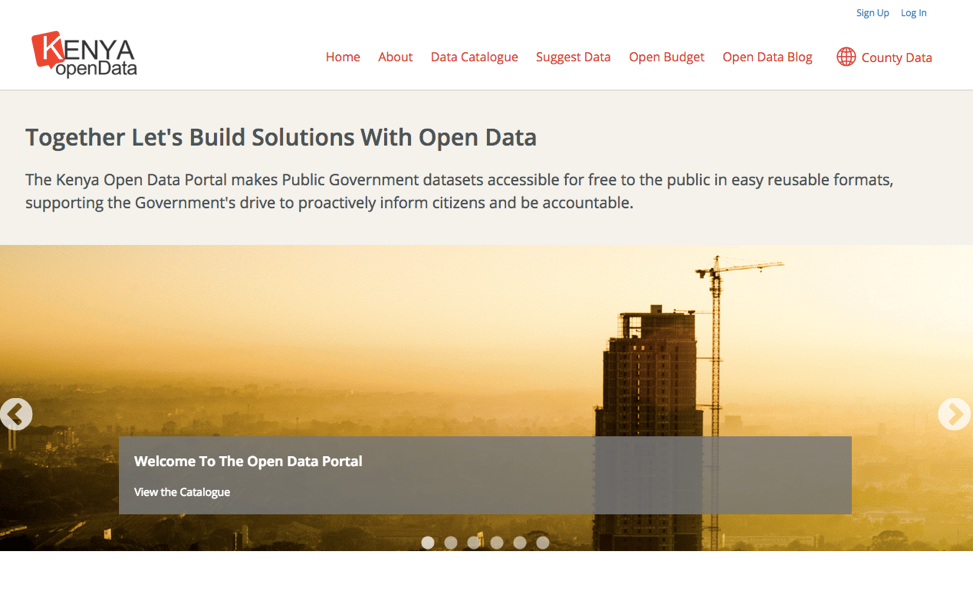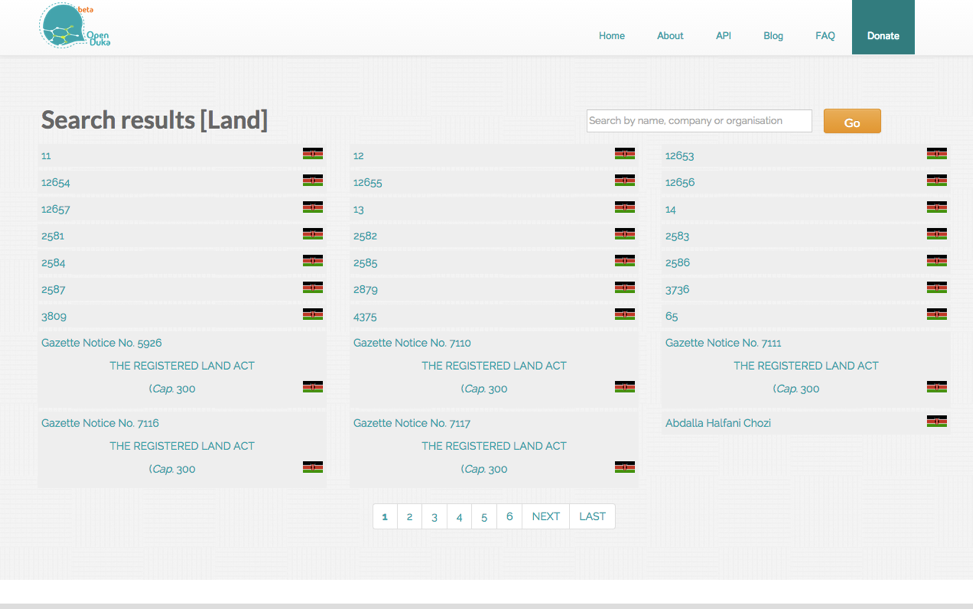The Global Impact of Open Data
Kenya's Open Duka
Open Data for Transactional Transparency
by Andrew Young and Stefaan Verhulst*
Reference
2http://www.businessinsider.com/afp-corruption-in-kenya-worse-than-ever-says-veteran-campaigner-2015-8?IR=T
3http://www.ucl.ac.uk/dpu-projects/drivers_urb_change/urb_governance/pdf_trans_corrupt/TI_Corruption_kenya.pdf, p. 7.
4Loeb, Saul. “Barack Obama urges Kenya to fight corruption in government.” Daily Nation. July 26, 2015. http://www.nation.co.ke/news/Fight-corruption-from-the-top-Obama/-/1056/2809526/-/2y8ovu/-/index.html
6Gilpin, Lyndsey. “The world’s unlikely leader in mobile payments: Kenya.” TechRepublic. March 20, 2014.
http://www.techrepublic.com/article/the-worlds-unlikely-leader-in-mobile-payments-kenya/
7Mutuku, Leonida and Christine M. Mahihu. “Open Data in Developing Countries – Understanding the Impacts of Kenya Open Data Applications and Services.” iHub Research. 2014. http://www.opendataresearch.org/sites/default/files/publications/ODDC%20Report%20iHub.pdf
8GovLab Interview with Dr. Bitange Ndemo, Chairman Open Institute. September 9, 2015.
9Mutegi, Lilian. “Kenya Open Data Portal Hits 44 Million Page VIews.” All Africa. August 18, 2015. http://allafrica.com/stories/201508190752.html.
10Mutuki, Leonida, Christine M. Mahihu, Dr. Raed Sharif. “Exploratory Study on the Role and Impact of Kenyan Open Data Technology Intermediaries.” iHub Research. April 30, 2014. http://www.opendataresearch.org/sites/default/files/publications/ODDC%20Report%20iHub.pdf
11Ochieng, Lilian. “Kenya: State Agencies Hold Firmly to Their Data.” AllAfrica. August 19, 2015. http://allafrica.com/stories/201508200439.html.
12H.E. President Uhuru Kenyatta. “The Harmonised Jubilee Coalition Manifesto.” http://www.scribd.com/doc/123569244/The-Harmonised-Jubilee-Coalition-Manifesto#scribd.
13H.E. President Uhuru Kenyatta. “The Harmonised Jubilee Coalition Manifesto.” http://www.scribd.com/doc/123569244/The-Harmonised-Jubilee-Coalition-Manifesto#scribd.
14Brown, Greg. “Why Kenya’s open data portal is failing – and why it can still succeed.” Sunlight Foundation. September 23, 2013. https://sunlightfoundation.com/blog/2013/09/23/why-kenyas-open-data-portal-is-failing-and-why-it-can-still-succeed/.
15GovLab Interview with Jay Bhalla, Executive Director of the Open Institute Trust. August 12, 2015.
16GovLab Interview with Al Kags, Founder Open Institute. March 4, 2014. https://www.youtube.com/watch?v=GYfovn5TQpI.
17 GovLab Interview with Jay Bhalla, Executive Director of the Open Institute Trust. August 12, 2015.
18 GovLab Interview with Al Kags, Founder Open Institute. March 4, 2014. https://www.youtube.com/watch?v=GYfovn5TQpI.
19 GovLab Interview with Al Kags, Founder Open Institute. March 4, 2014. https://www.youtube.com/watch?v=GYfovn5TQpI.
20 GovLab Interview with Al Kags, Founder Open Institute. March 4, 2014. https://www.youtube.com/watch?v=GYfovn5TQpI.
22 GovLab Interview with Al Kags, Founder Open Institute. March 4, 2014. https://www.youtube.com/watch?v=GYfovn5TQpI.
23 “G20 High-Level Principles on Beneficial Ownership Transparency.” G20.org. December 2014. https://g20.org/wp-content/uploads/2014/12/g20_high-level_principles_beneficial_ownership_transparency.pdf
24 GovLab Interview with Jay Bhalla, Executive Director of the Open Institute Trust. August 12, 2015.
25 GovLab Interview with Jay Bhalla, Executive Director of the Open Institute Trust. August 12, 2015.
26 GovLab Interview with Dr. Bitange Ndemo, Chairman Open Institute. September 9, 2015.
27 Walker, Emily. “And the Honesty Oscars go to…” One.org. February 23, 2015. http://www.one.org/us/2015/02/23/and-the-honesty-oscars-go-to/.
28 GovLab Interview with Dr. Bitange Ndemo, Chairman Open Institute. September 9, 2015.
29 GovLab Interview with Dr. Bitange Ndemo, Chairman Open Institute. September 9, 2015.
30 GovLab Interview with Jay Bhalla, Executive Director of the Open Institute Trust. August 12, 2015.
32 Mutegi, Lilian. “Kenya Open Data Portal Hits 44 Million Page Views.” All Africa. August 18, 2015. http://allafrica.com/stories/201508190752.html.
33 GovLab Interview with Jay Bhalla, Executive Director of the Open Institute Trust. August 12, 2015.
34 GovLab Interview with Jay Bhalla, Executive Director of the Open Institute Trust. August 12, 2015.
35 GovLab Interview with Jay Bhalla, Executive Director of the Open Institute Trust. August 12, 2015.
36 GovLab Interview with Jay Bhalla, Executive Director of the Open Institute Trust. August 12, 2015.
37 GovLab Interview with Jay Bhalla, Executive Director of the Open Institute Trust. August 12, 2015.
38 GovLab Interview with Jay Bhalla, Executive Director of the Open Institute Trust. August 12, 2015.
39 GovLab Interview with Jay Bhalla, Executive Director of the Open Institute Trust. August 12, 2015.
40 GovLab Interview with Jay Bhalla, Executive Director of the Open Institute Trust. August 12, 2015.
41 GovLab Interview with Jay Bhalla, Executive Director of the Open Institute Trust. August 12, 2015.
42 GovLab Interview with Dr. Bitange Ndemo, Chairman Open Institute. September 9, 2015.
43 GovLab Interview with Al Kags, Founder Open Institute. March 4, 2014. https://www.youtube.com/watch?v=GYfovn5TQpI.





